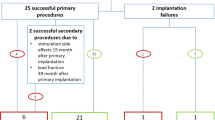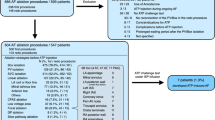Abstract
In cardiac resynchronization therapy (CRT), the electrical impulse delivered by the left ventricular (LV) lead may incidentally cause phrenic nerve stimulation (PNS). The purpose of this state-of-the-art review is to describe the frequency, risk factors, and clinical consequences of PNS and to present the most recent options to successfully manage PNS. PNS occurs in 2 to 37 % of implanted patients and is not always detected in the supine position during implantation. Lateral and posterior veins are at higher risk of PNS than anterior veins, and apical positions are at higher risk of PNS than basal positions. The management of PNS discovered during implantation may include mapping the course of the target vein in order to find a PNS-free site, targeting another vein if available, and pacing with alternative configurations before changing the lead location. Non-invasive options for management of post-operative PNS depend on the difference between PNS and LV stimulation thresholds and include reducing the LV pacing output, automatic determination of LV stimulation threshold and minimal output delivery by the device, increasing the pulse duration, and electronic repositioning. New quadripolar leads allow to pace from different cathodes, and the multiple pacing configurations available have proved superior to bipolar leads in mitigating PNS. This electronic repositioning addresses almost all of the clinically relevant PNS and should markedly reduce the need for invasive lead repositioning or CRT abandon, which is actually the last option for 2 % of patients.

Similar content being viewed by others
References
Singh, J. P., Klein, H. U., Huang, D. T., Reek, S., Kuniss, M., Quesada, A., et al. (2011). Left ventricular lead position and clinical outcome in the multicenter automatic defibrillator implantation trial-cardiac resynchronization therapy (MADIT-CRT) trial. Circulation, 123(11), 1159–1166.
Thebault, C., Donal, E., Meunier, C., Gervais, R., Gerritse, B., Gold, M. R., et al. (2012). Sites of left and right ventricular lead implantation and response to cardiac resynchronization therapy observations from the REVERSE trial. European Heart Journal, 33(21), 2662–2671.
Sanchez-Quintana, D., Ho, S. Y., Climent, V., Murillo, M., & Cabrera, J. A. (2009). Anatomic evaluation of the left phrenic nerve relevant to epicardial and endocardial catheter ablation: implications for phrenic nerve injury. Heart Rhythm, 6(6), 764–768.
Sanchez-Quintana, D., Cabrera, J. A., Climent, V., Farre, J., Weiglein, A., & Ho, S. Y. (2005). How close are the phrenic nerves to cardiac structures? Implications for cardiac interventionalists. Journal of Cardiovascular Electrophysiology, 16(3), 309–313.
Albertsen, A. E., Nielsen, J. C., Pedersen, A. K., Hansen, P. S., Jensen, H. K., & Mortensen, P. T. (2005). Left ventricular lead performance in cardiac resynchronization therapy: impact of lead localization and complications. Pacing and Clinical Electrophysiology, 28(6), 483–488.
Biffi, M., Exner, D. V., Crossley, G. H., Ramza, B., Coutu, B., Tomassoni, G., et al. (2013). Occurrence of phrenic nerve stimulation in cardiac resynchronization therapy patients: the role of left ventricular lead type and placement site. Europace, 15(1), 77–82.
Biffi, M., Moschini, C., Bertini, M., Saporito, D., Ziacchi, M., Diemberger, I., et al. (2009). Phrenic stimulation: a challenge for cardiac resynchronization therapy. Circulation. Arrhythmia and Electrophysiology, 2(4), 402–410.
Biffi, M., Foerster, L., Eastman, W., Eggen, M., Grenz, N. A., Sommer, J., et al. (2012). Effect of bipolar electrode spacing on phrenic nerve stimulation and left ventricular pacing thresholds: an acute canine study. Circulation. Arrhythmia and Electrophysiology, 5(4), 815–820.
Biffi, M., Zanon, F., Bertaglia, E., Padeletti, L., Varbaro, A., De Santo, T., et al. (2013). Short-spaced dipole for managing phrenic nerve stimulation in patients with CRT: the “phrenic nerve mapping and stimulation EP” catheter study. Heart Rhythm, 10(1), 39–45.
Wecke, L., van Hunnik, A., Thompson, T., DiCarlo, L., Zdeblick, M., Auricchio, A., et al. (2012). Networked multielectrode left ventricular pacing lead for avoidance of phrenic nerve stimulation in a canine model. Heart Rhythm, 9(5), 789–795.
Knight, B. P., Desai, A., Coman, J., Faddis, M., & Yong, P. (2004). Long-term retention of cardiac resynchronization therapy. Journal of the American College of Cardiology, 44(1), 72–77.
Chino, J. P., & Marks, L. B. (2008). Prone positioning causes the heart to be displaced anteriorly within the thorax: implications for breast cancer treatment. International Journal of Radiation Oncology, Biology, Physics, 70(3), 916–920.
Burri, H., Gerritse, B., Davenport, L., Demas, M., & Sticherling, C. (2009). Fluctuation of left ventricular thresholds and required safety margin for left ventricular pacing with cardiac resynchronization therapy. Europace, 11(7), 931–936.
Alonso, C., Leclercq, C., d’Allonnes, F. R., Pavin, D., Victor, F., Mabo, P., et al. (2001). Six year experience of transvenous left ventricular lead implantation for permanent biventricular pacing in patients with advanced heart failure: technical aspects. Heart, 86(4), 405–410.
Biffi, M., Bertini, M., Ziacchi, M., Gardini, B., Mazzotti, A., Massaro, G., et al. (2011). Management of phrenic stimulation in CRT patients over the long term: still an unmet need ? Pacing and Clinical Electrophysiology, 34(10), 1201–1208.
Seifert, M., Schau, T., Moeller, V., Neuss, M., Meyhoefer, J., & Butter, C. (2010). Influence of pacing configurations, body mass index, and position of coronary sinus lead on frequency of phrenic nerve stimulation and pacing thresholds under cardiac resynchronization therapy. Europace, 12(7), 961–967.
Gurevitz, O., Nof, E., Carasso, S., Luria, D., Bar-Lev, D., Tanami, N., et al. (2005). Programmable multiple pacing configurations help to overcome high left ventricular pacing thresholds and avoid phrenic nerve stimulation. Pacing and Clinical Electrophysiology, 28(12), 1255–1259.
Matsumoto, Y., Krishnan, S., Fowler, S. J., Saremi, F., Kondo, T., Ahsan, C., et al. (2007). Detection of phrenic nerves and their relation to cardiac anatomy using 64-slice multidetector computed tomography. American Journal of Cardiology, 100(1), 133–137.
Blendea, D., Shah, R. V., Auricchio, A., Nandigam, V., Orencole, M., Heist, E. K., et al. (2007). Variability of coronary venous anatomy in patients undergoing cardiac resynchronization therapy: a high-speed rotational venography study. Heart Rhythm, 4(9), 1155–1162.
Tomassoni, G., Baker, J., Corbisiero, R., Love, C., Martin, D., Niazi, I., et al. (2013). Postoperative performance of the Quartet® left ventricular heart lead. Journal of Cardiovascular Electrophysiology, 24(4), 449–456.
Chan, N. Y., Choy, C. C., Lau, C. L., Lo, Y. K., Chu, P. S., Yuen, H. C., et al. (2011). Utility of a novel pacing guidewire in pre-implantation testing at different left ventricular sites in cardiac resynchronization therapy procedures. Journal of Interventional Cardiac Electrophysiology, 32(1), 67–71.
Huizar, J. F., Kaszala, K., Koneru, J. N., Thacker, L. R., & Ellenbogen, K. A. (2013). Comparison of different pacing strategies to minimize phrenic nerve stimulation in cardiac resynchronization therapy. Journal of Cardiovascular Electrophysiology, 24(9), 1008–1014.
Gellér, L., Szilágyi, S., Zima, E., Molnár, L., Széplaki, G., Végh, E. M., et al. (2011). Long-term experience with coronary sinus side branch stenting to stabilize left ventricular electrode position. Heart Rhythm, 8(6), 845–850.
Jastrzebski, M., Bacior, B., Wojciechowska, W., & Czarnecka, D. (2011). Left ventricular lead implantation at a phrenic stimulation site is safe and effective. Europace, 13(4), 520–525.
Poole, J. E., Gleva, M. J., Mela, T., Chung, M. K., Uslan, D. Z., Borge, R., et al. (2010). Complication rates associated with pacemaker or implantable cardioverter-defibrillator generator replacements and upgrade procedures: results from the REPLACE registry. Circulation, 122(16), 1553–1561.
Biffi, M., Bertini, M., Saporito, D., Ziacchi, M., Stabellini, S., Valsecchi, S., et al. (2009). Automatic management of left ventricular stimulation: hints for technologic improvement. Pacing and Clinical Electrophysiology, 32(3), 346–353.
Kalahasty, G., Giudici, M., Lobban, J., Doshi, R., Delaney, C., Shome, S., et al. (2012). Acute clinical evaluation of a left ventricular automatic threshold determination algorithm based on evoked response sensing. Pacing and Clinical Electrophysiology, 35(3), 348–356.
Hjortshoj, S., Heath, F., Haugland, M., Eschen, O., Thogersen, A. M., Riahi, S., et al. (2013). Long pacing pulses reduce phrenic nerve stimulation in left ventricular pacing. Journal of Cardiovascular Electrophysiology, 25(5), 485–90.
Champagne, J., Healey, J. S., Krahn, A. D., Philippon, F., Gurevitz, O., Swearingen, A., et al. (2011). The effect of electronic repositioning on left ventricular pacing and phrenic nerve stimulation. Europace, 13(3), 409–415.
Klein, N., Klein, M., Weglage, H., Przibille, O., Fischer, S., Trappe, H. J., et al. (2012). Clinical efficacy of left ventricular pacing vector programmability in cardiac resynchronization therapy defibrillator patients for management of phrenic nerve stimulation and/or elevated left ventricular pacing thresholds: insights from the Efface Phrenic Stim study. Europace, 14(6), 826–832.
Goetze, S., Defaye, P., Bauer, A., Merkel, M., Bizeau, O., Treusch, S., et al. (2013). Phrenic nerve stimulation in CRT patients and benefits of electronic lead repositioning: the ERACE trial. Journal of Interventional Cardiac Electrophysiology, 38(1), 1–9.
Vado, A., Menardi, E., Rossetti, G., Ballari, G., Feola, M., & Bobbio, M. (2013). Single-center experience of a quadripolar pacing lead for cardiac resynchronization therapy. Journal of Interventional Cardiac Electrophysiology, 39(2), 161–165.
Forleo, G. B., Mantica, M., Di Biase, L., Panattoni, G., Della Rocca, D. G., Papavasileiou, L. P., et al. (2012). Clinical and procedural outcome of patients implanted with a quadripolar left ventricular lead: early results of a prospective multicenter study. Heart Rhythm, 9(11), 1822–1828.
Sperzel, J., Danschel, W., Gutleben, K. J., Kranig, W., Mortensen, P., Connelly, D., et al. (2012). First prospective, multi-centre clinical experience with a novel left ventricular quadripolar lead. Europace, 14(3), 365–372.
Mehta, P. A., Shetty, A. K., Squirrel, M., Bostock, J., & Rinaldi, C. A. (2012). Elimination of phrenic nerve stimulation occurring during CRT: follow-up in patients implanted with a novel quadripolar pacing lead. Journal of Interventional Cardiac Electrophysiology, 33(1), 43–49.
Shetty, A. K., Duckett, S. G., Bostock, J., Roy, D., Ginks, M., Hamid, S., et al. (2011). Initial single-center experience of a quadripolar pacing lead for cardiac resynchronization therapy. Pacing and Clinical Electrophysiology, 34(4), 484–489.
Szilágyi, S., Merkely, B., Zima, E., Kutyifa, V., Szucs, G., Fülöp, G., et al. (2008). Minimal invasive coronary sinus lead reposition technique for the treatment of phrenic nerve stimulation. Europace, 10(10), 1157–1160.
Doguet, F., Honore, C., Godin, B., & Anselme, F. (2012). Isolation of the phrenic nerve to suppress diaphragmatic contraction induced by cardiac resynchronization. Journal of Cardiovascular Electrophysiology, 23(7), 778–780.
van Steenberghe, M., Pruvot, E., Delay, D., Delacretaz, E., & Ruchat, P. (2011). Insulation of the phrenic nerve as an alternative to left ventricular lead repositioning in cardiac resynchronization therapy. International Journal of Cardiology, 147(2), 328–329.
Mediratta, N., Barker, D., McKevith, J., Davies, P., Belchambers, S., & Rao, A. (2012). Thoracoscopic patch insulation to correct phrenic nerve stimulation secondary to cardiac resynchronization therapy. Europace, 14(7), 1049–1053.
Conflict of interest
None.
Financial support
None.
Author information
Authors and Affiliations
Corresponding author
Rights and permissions
About this article
Cite this article
Moubarak, G., Bouzeman, A., Ollitrault, J. et al. Phrenic nerve stimulation in cardiac resynchronization therapy. J Interv Card Electrophysiol 41, 15–21 (2014). https://doi.org/10.1007/s10840-014-9917-8
Received:
Accepted:
Published:
Issue Date:
DOI: https://doi.org/10.1007/s10840-014-9917-8




